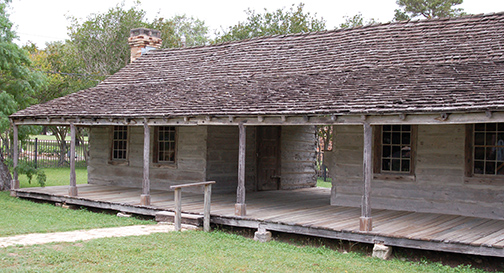
The Eggleston double cabin, now at Gonzales, is typical of early settlers' homes.
Texas Rangers' next foray encountered tragedies
Note: This continues the account of William Magill's time with the Texas Rangers in 1835.
Several additional companies responded to Robert Coleman's call for reinforcements, and they gathered at Parker's Fort. In early August, they moved as a single force, under Colonel John H. Moore, on a second campaign up the Brazos River. Heading northeast, they reached a Tawakoni village, which they found evacuated. Moore’s troops left after two days and traveled twenty miles over prairie to Post Oak Creek, a tributary of the Trinity River.
Scouts reported Indians in the area, and rangers formed into battle lines. Moore and adjutant James Neill held fifteen minutes of parade and maneuvers, then ordered the men to charge over boggy soil for several hundred yards through timber. The Indians fled, and the rangers pursued them for several more days through swollen streams and muddy bogs. Finding a small camp of Wacos, they killed one and captured five or six. Though the prisoners told them a larger group was camped shortly ahead, the Texans never encountered them. They traveled up the Trinity River as far as present day Dallas, crossed to the Brazos River, and followed it down, encountering five or six more Indians along the way.
During the reorganization at Parker’s Fort, William had moved from Coleman’s company to one led by Robert M. Williamson, where he served from July 25 until mustering out September 13. Williamson was a colorful, popular leader. In the fall, he would represent Bastrop (Mina) in the Consultation that established the provisional Texas government, which retroactively authorized the four companies from the summer as the first Texas Rangers battalion. Many historians consider the men of Coleman’s company to be the first official Rangers of Texas.
William was a member of Captain Williamson’s Mounted Riflemen as they scouted north, tracking Indian bands, hunting their food, and sleeping on the ground. They were taking the half dozen captured Waco Indians back to Bastrop, a journey of more than one hundred miles. Among them was a woman with a three-year-old daughter. Jenkins wrote, “The child was charming and pretty, and the men made much of her.”
One night, while camped along the Brazos River, the mother stole a knife and killed her child; she then tried to kill herself. She was found in the morning badly cut but still alive. George Erath, a ranger, is quoted in Moore’s history: “Edward Burleson, deciding that the suffering Indian woman would bleed to death shortly, asked for a volunteer to kill her to spare her further suffering. Oliver Buckman of Captain Williamson’s company came forward for the mercy mission. Taking her to the edge of the river, he drew his large, homemade hack knife. Gazing straight into her face, Buckman severed with one stroke her head from her body, both of which rolled into the water beneath.’” Jenkins wrote that “she gazed unflinchingly into his face …”
The rangers were headed toward home on September 1 when they saw two young Indians on foot about half a mile away. Several rangers with the fastest horses pursued them into a thicket, surrounded the woods, and sent two men in. They shot one Indian and were hunting the second. One ranger, Moses S. Hornsby, had shot but missed, and the Indian shot back, wounding Hornsby in the shoulder.
Hornsby, shouting, “Here’s the Indian!” stumbled from the brush. Jenkins wrote, “One of Williamson’s rangers, William Magill, heard the cry of ‘Indian’ and raised his rifle. In his haste to kill, he fired at the first person to rush from the brush, hitting his fellow man. Magill’s shot shredded poor Hornsby’s arm.” A physician attached to the company examined him and decided that an amputation would be required to save his life. Hornsby solidly refused to lose his arm, stating that he preferred death. “After lingering along in great pain for a day or two, he got his wish and was buried with the honors of a volunteer soldier,” Jenkins wrote.
Jenkins adds that the adjutant, James Neill, tried to return “destruction to the enemy tribes. He had procured some type of smallpox virus and had this bacteria injected into one of the Indians his men had captured. This Indian was then released and allowed to carry the infection back to his tribe. Neill was never able to ascertain the success or failure of his little experiment.”
When the volunteers mustered out in Bastrop, it would be only a few weeks before many of them volunteered again. In early October, news came that settlers in Gonzales were refusing to return a small cannon Mexican troops had loaned them for self-defense. The standoff turned into a battle, and the shots fired signaled that the Texans’ revolt from Mexico had begun.
William rushed to join up in October, “riding night and day” to join other militiamen gathering near San Antonio.
